Qantas Airlines: Strategic Analysis using Porter's Five Forces Model
VerifiedAdded on 2023/06/08
|10
|2101
|198
Report
AI Summary
This report offers a comprehensive strategic analysis of Qantas Airlines, a major player in the Australian aviation industry. It begins with an industry analysis using Porter's Five Forces, assessing the threat of new entrants, substitutes, competitive rivalry, and the bargaining power of suppliers and buyers. The internal analysis then focuses on a SWOT analysis, identifying Qantas's strengths, weaknesses, opportunities, and threats, including its strong brand image, struggles with labor unions, potential for international expansion, and competition from other airlines. Furthermore, the report evaluates Qantas's business-level strategy through a value chain analysis, examining primary activities like sales and marketing, research and development, customer service, and production, as well as secondary activities such as human resource management and infrastructure. The analysis considers both the Qantas and Jetstar brands, providing a holistic view of the airline's strategic position and operational activities. This detailed assessment highlights the key factors influencing Qantas's competitive advantage and overall business performance.
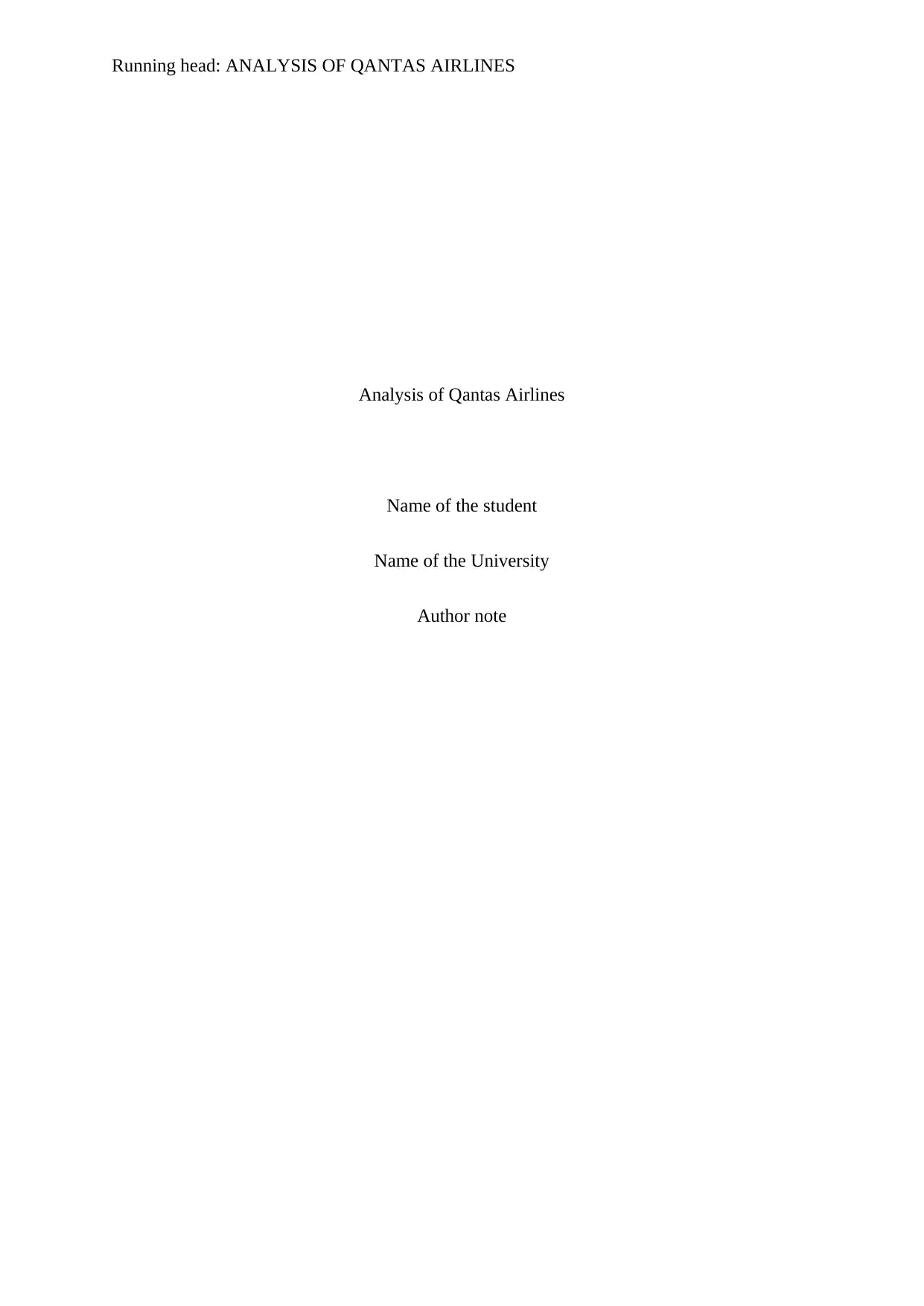
Running head: ANALYSIS OF QANTAS AIRLINES
Analysis of Qantas Airlines
Name of the student
Name of the University
Author note
Analysis of Qantas Airlines
Name of the student
Name of the University
Author note
Paraphrase This Document
Need a fresh take? Get an instant paraphrase of this document with our AI Paraphraser
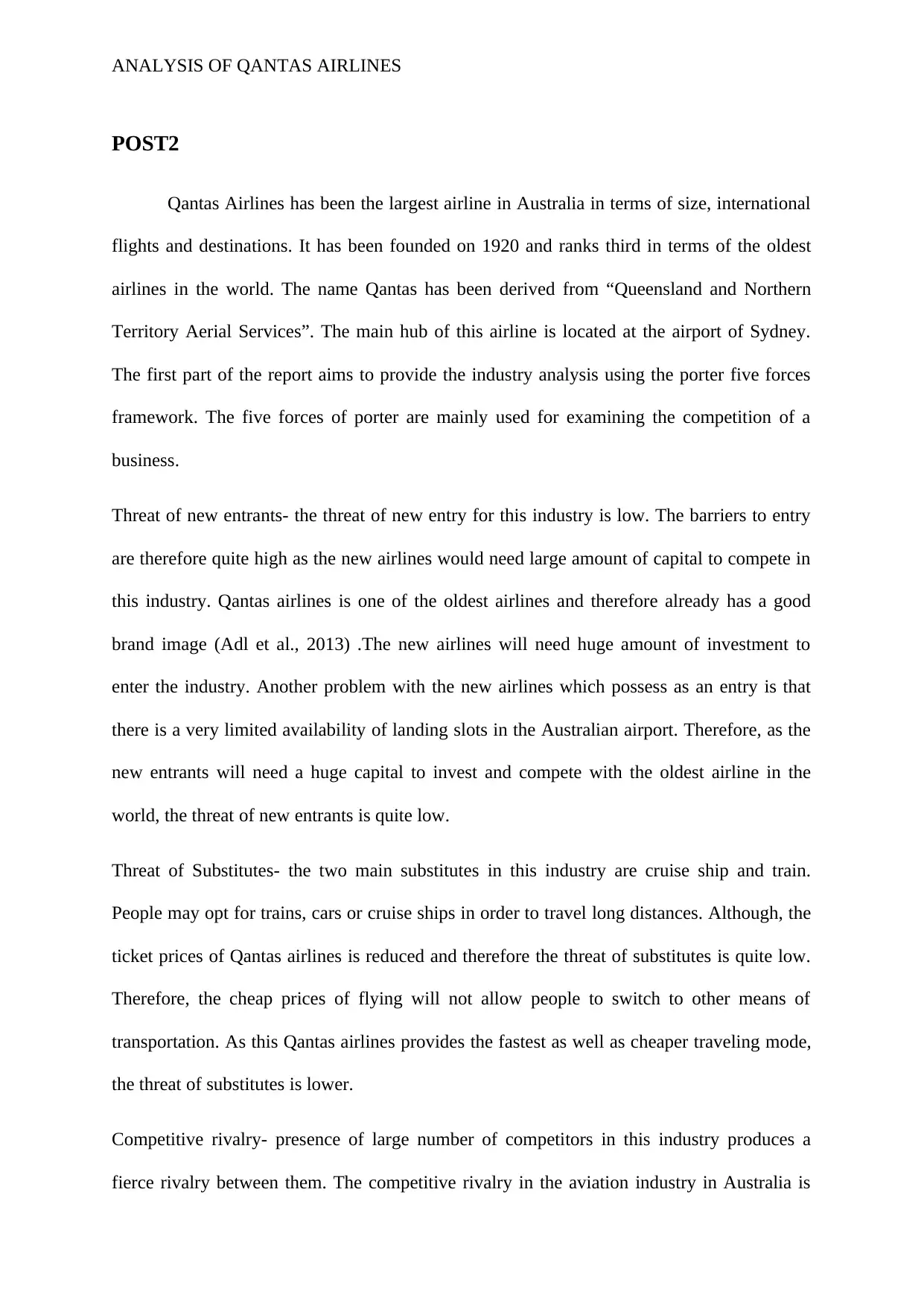
ANALYSIS OF QANTAS AIRLINES
POST2
Qantas Airlines has been the largest airline in Australia in terms of size, international
flights and destinations. It has been founded on 1920 and ranks third in terms of the oldest
airlines in the world. The name Qantas has been derived from “Queensland and Northern
Territory Aerial Services”. The main hub of this airline is located at the airport of Sydney.
The first part of the report aims to provide the industry analysis using the porter five forces
framework. The five forces of porter are mainly used for examining the competition of a
business.
Threat of new entrants- the threat of new entry for this industry is low. The barriers to entry
are therefore quite high as the new airlines would need large amount of capital to compete in
this industry. Qantas airlines is one of the oldest airlines and therefore already has a good
brand image (Adl et al., 2013) .The new airlines will need huge amount of investment to
enter the industry. Another problem with the new airlines which possess as an entry is that
there is a very limited availability of landing slots in the Australian airport. Therefore, as the
new entrants will need a huge capital to invest and compete with the oldest airline in the
world, the threat of new entrants is quite low.
Threat of Substitutes- the two main substitutes in this industry are cruise ship and train.
People may opt for trains, cars or cruise ships in order to travel long distances. Although, the
ticket prices of Qantas airlines is reduced and therefore the threat of substitutes is quite low.
Therefore, the cheap prices of flying will not allow people to switch to other means of
transportation. As this Qantas airlines provides the fastest as well as cheaper traveling mode,
the threat of substitutes is lower.
Competitive rivalry- presence of large number of competitors in this industry produces a
fierce rivalry between them. The competitive rivalry in the aviation industry in Australia is
POST2
Qantas Airlines has been the largest airline in Australia in terms of size, international
flights and destinations. It has been founded on 1920 and ranks third in terms of the oldest
airlines in the world. The name Qantas has been derived from “Queensland and Northern
Territory Aerial Services”. The main hub of this airline is located at the airport of Sydney.
The first part of the report aims to provide the industry analysis using the porter five forces
framework. The five forces of porter are mainly used for examining the competition of a
business.
Threat of new entrants- the threat of new entry for this industry is low. The barriers to entry
are therefore quite high as the new airlines would need large amount of capital to compete in
this industry. Qantas airlines is one of the oldest airlines and therefore already has a good
brand image (Adl et al., 2013) .The new airlines will need huge amount of investment to
enter the industry. Another problem with the new airlines which possess as an entry is that
there is a very limited availability of landing slots in the Australian airport. Therefore, as the
new entrants will need a huge capital to invest and compete with the oldest airline in the
world, the threat of new entrants is quite low.
Threat of Substitutes- the two main substitutes in this industry are cruise ship and train.
People may opt for trains, cars or cruise ships in order to travel long distances. Although, the
ticket prices of Qantas airlines is reduced and therefore the threat of substitutes is quite low.
Therefore, the cheap prices of flying will not allow people to switch to other means of
transportation. As this Qantas airlines provides the fastest as well as cheaper traveling mode,
the threat of substitutes is lower.
Competitive rivalry- presence of large number of competitors in this industry produces a
fierce rivalry between them. The competitive rivalry in the aviation industry in Australia is
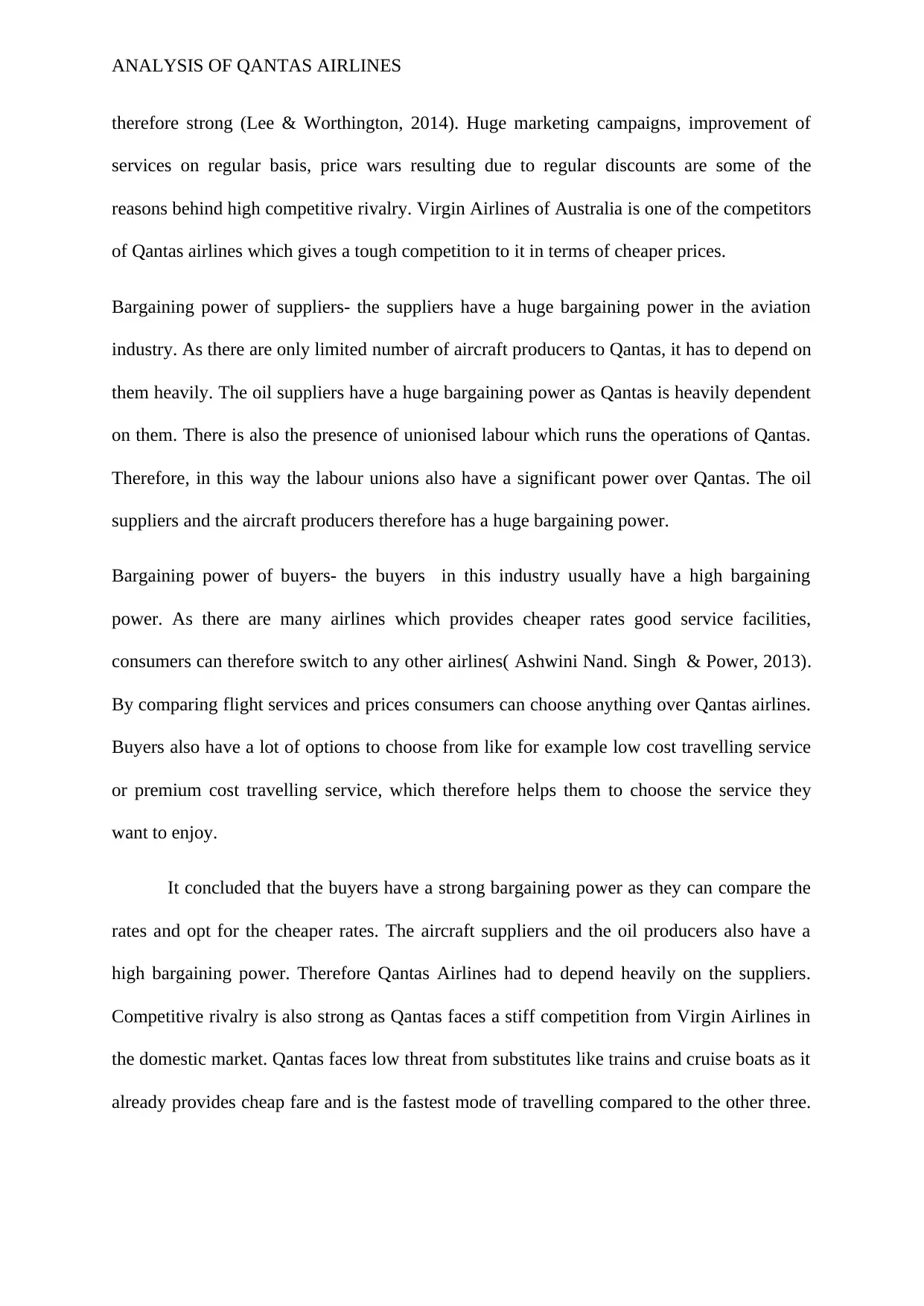
ANALYSIS OF QANTAS AIRLINES
therefore strong (Lee & Worthington, 2014). Huge marketing campaigns, improvement of
services on regular basis, price wars resulting due to regular discounts are some of the
reasons behind high competitive rivalry. Virgin Airlines of Australia is one of the competitors
of Qantas airlines which gives a tough competition to it in terms of cheaper prices.
Bargaining power of suppliers- the suppliers have a huge bargaining power in the aviation
industry. As there are only limited number of aircraft producers to Qantas, it has to depend on
them heavily. The oil suppliers have a huge bargaining power as Qantas is heavily dependent
on them. There is also the presence of unionised labour which runs the operations of Qantas.
Therefore, in this way the labour unions also have a significant power over Qantas. The oil
suppliers and the aircraft producers therefore has a huge bargaining power.
Bargaining power of buyers- the buyers in this industry usually have a high bargaining
power. As there are many airlines which provides cheaper rates good service facilities,
consumers can therefore switch to any other airlines( Ashwini Nand. Singh & Power, 2013).
By comparing flight services and prices consumers can choose anything over Qantas airlines.
Buyers also have a lot of options to choose from like for example low cost travelling service
or premium cost travelling service, which therefore helps them to choose the service they
want to enjoy.
It concluded that the buyers have a strong bargaining power as they can compare the
rates and opt for the cheaper rates. The aircraft suppliers and the oil producers also have a
high bargaining power. Therefore Qantas Airlines had to depend heavily on the suppliers.
Competitive rivalry is also strong as Qantas faces a stiff competition from Virgin Airlines in
the domestic market. Qantas faces low threat from substitutes like trains and cruise boats as it
already provides cheap fare and is the fastest mode of travelling compared to the other three.
therefore strong (Lee & Worthington, 2014). Huge marketing campaigns, improvement of
services on regular basis, price wars resulting due to regular discounts are some of the
reasons behind high competitive rivalry. Virgin Airlines of Australia is one of the competitors
of Qantas airlines which gives a tough competition to it in terms of cheaper prices.
Bargaining power of suppliers- the suppliers have a huge bargaining power in the aviation
industry. As there are only limited number of aircraft producers to Qantas, it has to depend on
them heavily. The oil suppliers have a huge bargaining power as Qantas is heavily dependent
on them. There is also the presence of unionised labour which runs the operations of Qantas.
Therefore, in this way the labour unions also have a significant power over Qantas. The oil
suppliers and the aircraft producers therefore has a huge bargaining power.
Bargaining power of buyers- the buyers in this industry usually have a high bargaining
power. As there are many airlines which provides cheaper rates good service facilities,
consumers can therefore switch to any other airlines( Ashwini Nand. Singh & Power, 2013).
By comparing flight services and prices consumers can choose anything over Qantas airlines.
Buyers also have a lot of options to choose from like for example low cost travelling service
or premium cost travelling service, which therefore helps them to choose the service they
want to enjoy.
It concluded that the buyers have a strong bargaining power as they can compare the
rates and opt for the cheaper rates. The aircraft suppliers and the oil producers also have a
high bargaining power. Therefore Qantas Airlines had to depend heavily on the suppliers.
Competitive rivalry is also strong as Qantas faces a stiff competition from Virgin Airlines in
the domestic market. Qantas faces low threat from substitutes like trains and cruise boats as it
already provides cheap fare and is the fastest mode of travelling compared to the other three.
⊘ This is a preview!⊘
Do you want full access?
Subscribe today to unlock all pages.

Trusted by 1+ million students worldwide
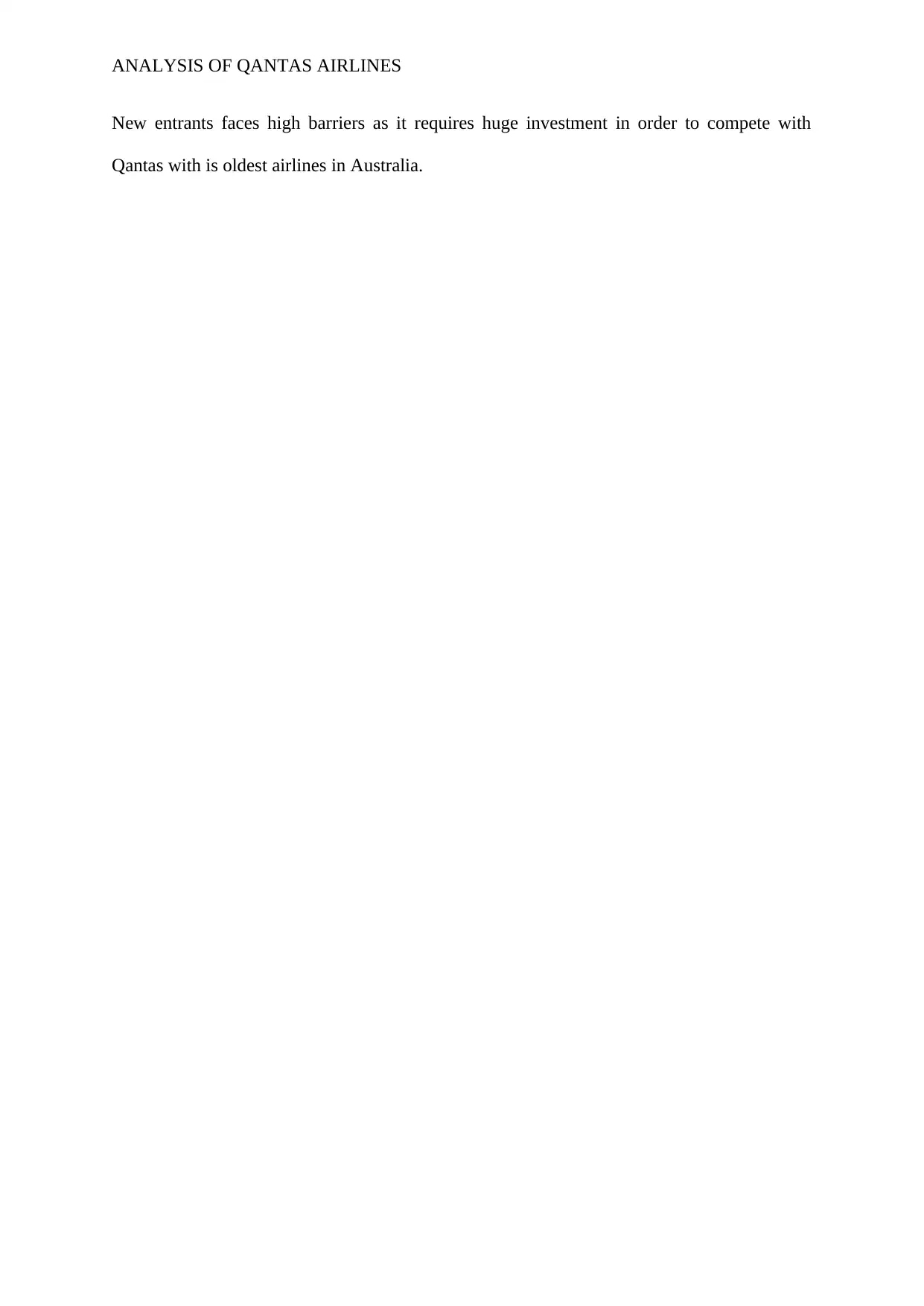
ANALYSIS OF QANTAS AIRLINES
New entrants faces high barriers as it requires huge investment in order to compete with
Qantas with is oldest airlines in Australia.
New entrants faces high barriers as it requires huge investment in order to compete with
Qantas with is oldest airlines in Australia.
Paraphrase This Document
Need a fresh take? Get an instant paraphrase of this document with our AI Paraphraser
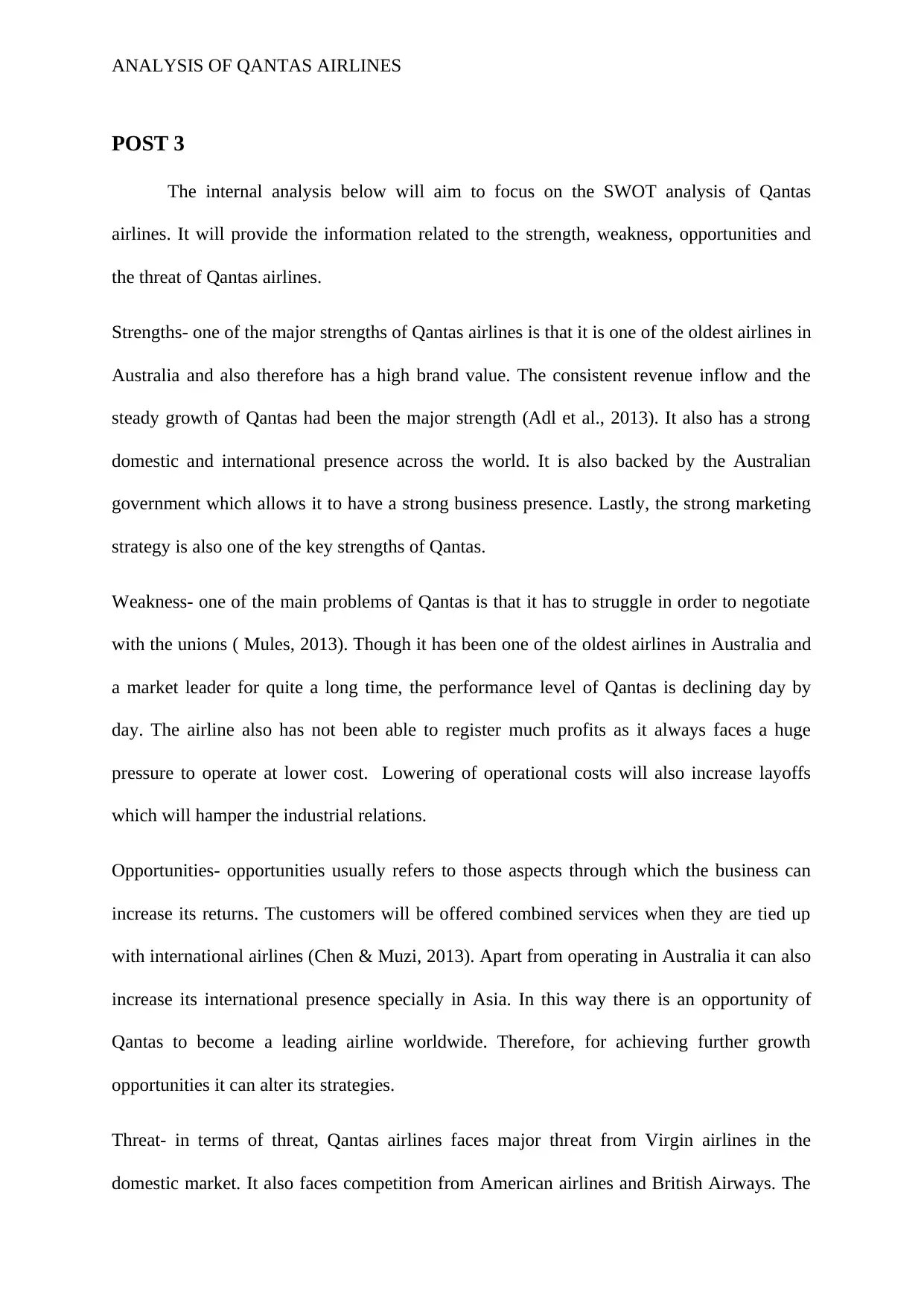
ANALYSIS OF QANTAS AIRLINES
POST 3
The internal analysis below will aim to focus on the SWOT analysis of Qantas
airlines. It will provide the information related to the strength, weakness, opportunities and
the threat of Qantas airlines.
Strengths- one of the major strengths of Qantas airlines is that it is one of the oldest airlines in
Australia and also therefore has a high brand value. The consistent revenue inflow and the
steady growth of Qantas had been the major strength (Adl et al., 2013). It also has a strong
domestic and international presence across the world. It is also backed by the Australian
government which allows it to have a strong business presence. Lastly, the strong marketing
strategy is also one of the key strengths of Qantas.
Weakness- one of the main problems of Qantas is that it has to struggle in order to negotiate
with the unions ( Mules, 2013). Though it has been one of the oldest airlines in Australia and
a market leader for quite a long time, the performance level of Qantas is declining day by
day. The airline also has not been able to register much profits as it always faces a huge
pressure to operate at lower cost. Lowering of operational costs will also increase layoffs
which will hamper the industrial relations.
Opportunities- opportunities usually refers to those aspects through which the business can
increase its returns. The customers will be offered combined services when they are tied up
with international airlines (Chen & Muzi, 2013). Apart from operating in Australia it can also
increase its international presence specially in Asia. In this way there is an opportunity of
Qantas to become a leading airline worldwide. Therefore, for achieving further growth
opportunities it can alter its strategies.
Threat- in terms of threat, Qantas airlines faces major threat from Virgin airlines in the
domestic market. It also faces competition from American airlines and British Airways. The
POST 3
The internal analysis below will aim to focus on the SWOT analysis of Qantas
airlines. It will provide the information related to the strength, weakness, opportunities and
the threat of Qantas airlines.
Strengths- one of the major strengths of Qantas airlines is that it is one of the oldest airlines in
Australia and also therefore has a high brand value. The consistent revenue inflow and the
steady growth of Qantas had been the major strength (Adl et al., 2013). It also has a strong
domestic and international presence across the world. It is also backed by the Australian
government which allows it to have a strong business presence. Lastly, the strong marketing
strategy is also one of the key strengths of Qantas.
Weakness- one of the main problems of Qantas is that it has to struggle in order to negotiate
with the unions ( Mules, 2013). Though it has been one of the oldest airlines in Australia and
a market leader for quite a long time, the performance level of Qantas is declining day by
day. The airline also has not been able to register much profits as it always faces a huge
pressure to operate at lower cost. Lowering of operational costs will also increase layoffs
which will hamper the industrial relations.
Opportunities- opportunities usually refers to those aspects through which the business can
increase its returns. The customers will be offered combined services when they are tied up
with international airlines (Chen & Muzi, 2013). Apart from operating in Australia it can also
increase its international presence specially in Asia. In this way there is an opportunity of
Qantas to become a leading airline worldwide. Therefore, for achieving further growth
opportunities it can alter its strategies.
Threat- in terms of threat, Qantas airlines faces major threat from Virgin airlines in the
domestic market. It also faces competition from American airlines and British Airways. The
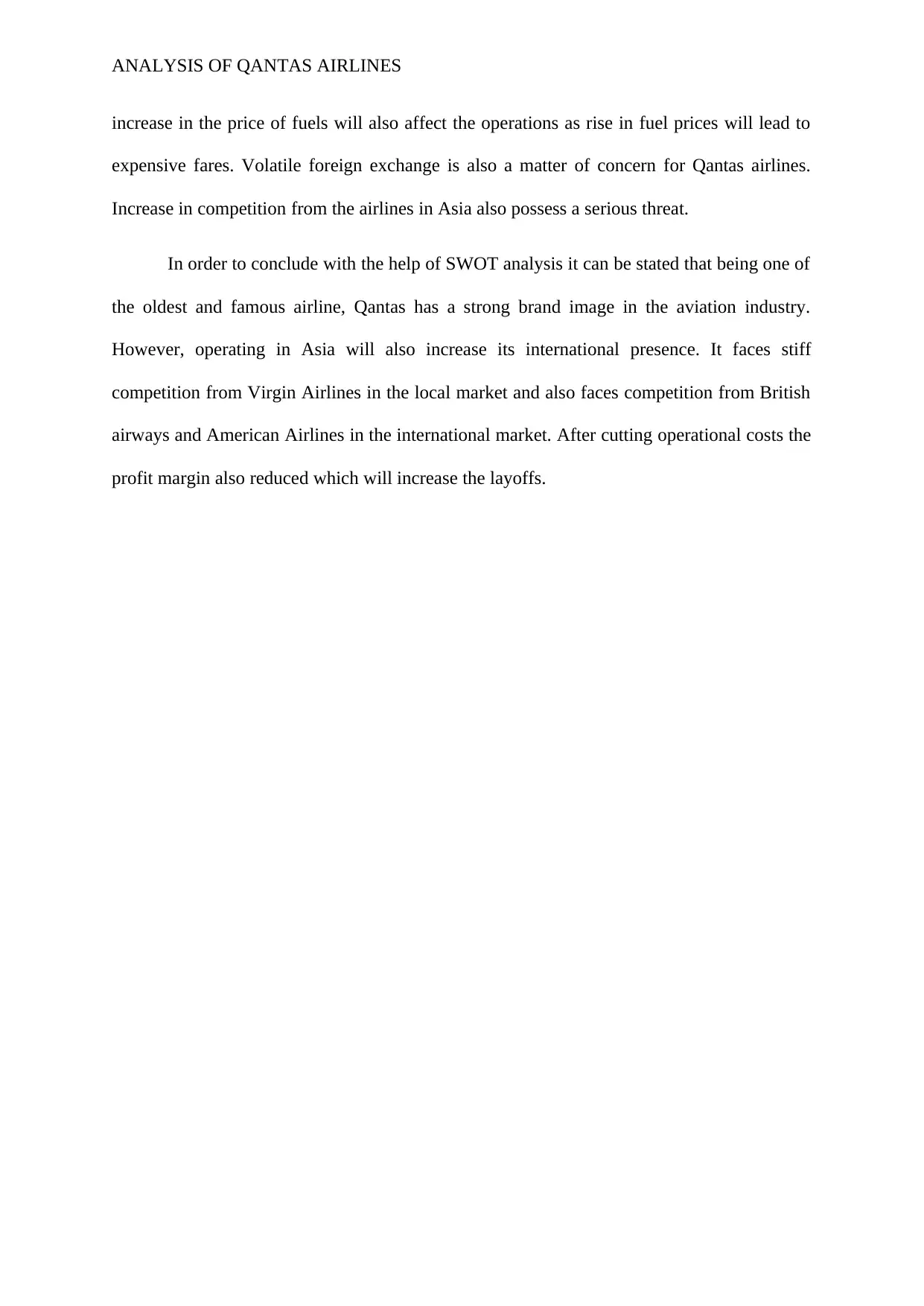
ANALYSIS OF QANTAS AIRLINES
increase in the price of fuels will also affect the operations as rise in fuel prices will lead to
expensive fares. Volatile foreign exchange is also a matter of concern for Qantas airlines.
Increase in competition from the airlines in Asia also possess a serious threat.
In order to conclude with the help of SWOT analysis it can be stated that being one of
the oldest and famous airline, Qantas has a strong brand image in the aviation industry.
However, operating in Asia will also increase its international presence. It faces stiff
competition from Virgin Airlines in the local market and also faces competition from British
airways and American Airlines in the international market. After cutting operational costs the
profit margin also reduced which will increase the layoffs.
increase in the price of fuels will also affect the operations as rise in fuel prices will lead to
expensive fares. Volatile foreign exchange is also a matter of concern for Qantas airlines.
Increase in competition from the airlines in Asia also possess a serious threat.
In order to conclude with the help of SWOT analysis it can be stated that being one of
the oldest and famous airline, Qantas has a strong brand image in the aviation industry.
However, operating in Asia will also increase its international presence. It faces stiff
competition from Virgin Airlines in the local market and also faces competition from British
airways and American Airlines in the international market. After cutting operational costs the
profit margin also reduced which will increase the layoffs.
⊘ This is a preview!⊘
Do you want full access?
Subscribe today to unlock all pages.

Trusted by 1+ million students worldwide
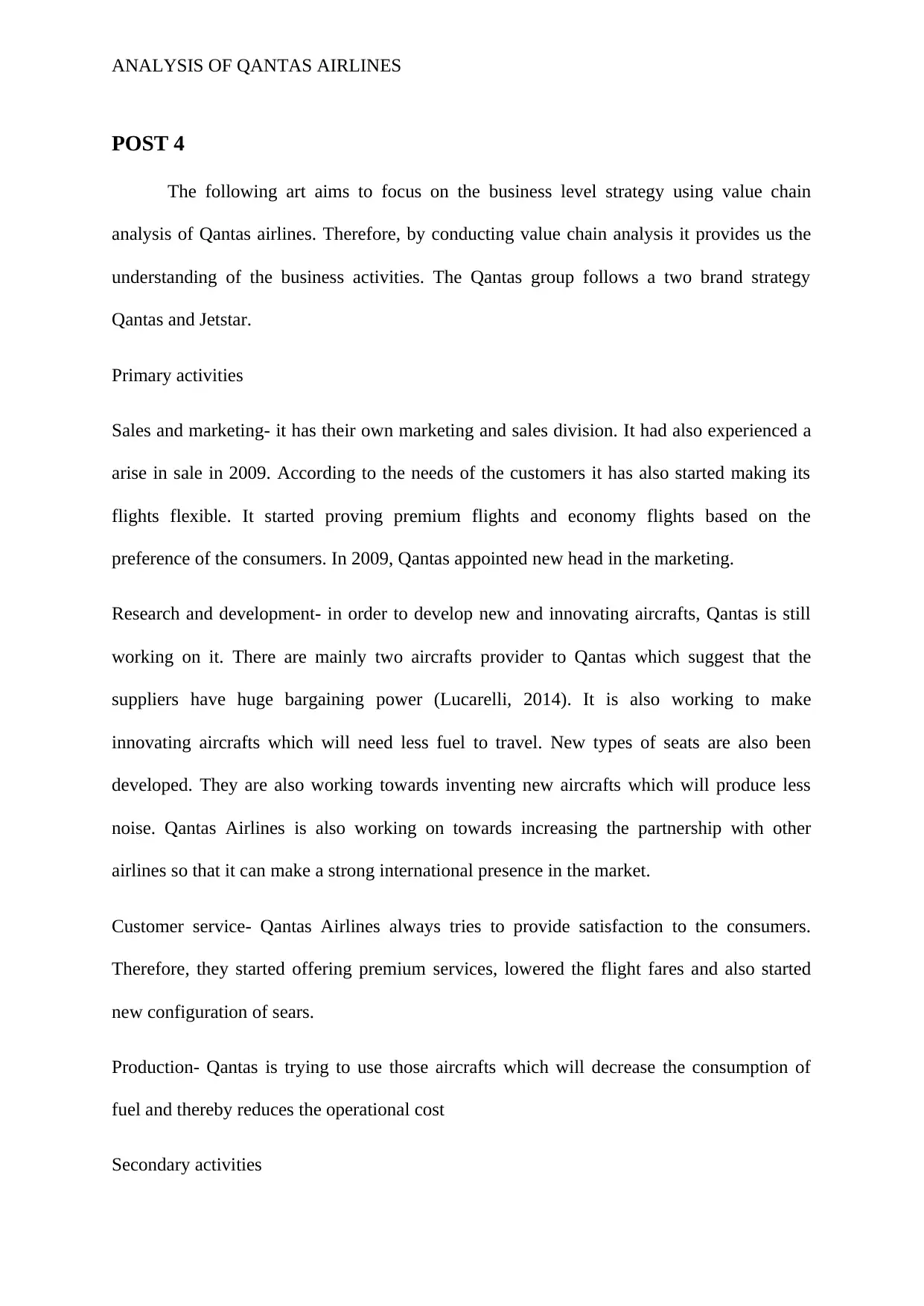
ANALYSIS OF QANTAS AIRLINES
POST 4
The following art aims to focus on the business level strategy using value chain
analysis of Qantas airlines. Therefore, by conducting value chain analysis it provides us the
understanding of the business activities. The Qantas group follows a two brand strategy
Qantas and Jetstar.
Primary activities
Sales and marketing- it has their own marketing and sales division. It had also experienced a
arise in sale in 2009. According to the needs of the customers it has also started making its
flights flexible. It started proving premium flights and economy flights based on the
preference of the consumers. In 2009, Qantas appointed new head in the marketing.
Research and development- in order to develop new and innovating aircrafts, Qantas is still
working on it. There are mainly two aircrafts provider to Qantas which suggest that the
suppliers have huge bargaining power (Lucarelli, 2014). It is also working to make
innovating aircrafts which will need less fuel to travel. New types of seats are also been
developed. They are also working towards inventing new aircrafts which will produce less
noise. Qantas Airlines is also working on towards increasing the partnership with other
airlines so that it can make a strong international presence in the market.
Customer service- Qantas Airlines always tries to provide satisfaction to the consumers.
Therefore, they started offering premium services, lowered the flight fares and also started
new configuration of sears.
Production- Qantas is trying to use those aircrafts which will decrease the consumption of
fuel and thereby reduces the operational cost
Secondary activities
POST 4
The following art aims to focus on the business level strategy using value chain
analysis of Qantas airlines. Therefore, by conducting value chain analysis it provides us the
understanding of the business activities. The Qantas group follows a two brand strategy
Qantas and Jetstar.
Primary activities
Sales and marketing- it has their own marketing and sales division. It had also experienced a
arise in sale in 2009. According to the needs of the customers it has also started making its
flights flexible. It started proving premium flights and economy flights based on the
preference of the consumers. In 2009, Qantas appointed new head in the marketing.
Research and development- in order to develop new and innovating aircrafts, Qantas is still
working on it. There are mainly two aircrafts provider to Qantas which suggest that the
suppliers have huge bargaining power (Lucarelli, 2014). It is also working to make
innovating aircrafts which will need less fuel to travel. New types of seats are also been
developed. They are also working towards inventing new aircrafts which will produce less
noise. Qantas Airlines is also working on towards increasing the partnership with other
airlines so that it can make a strong international presence in the market.
Customer service- Qantas Airlines always tries to provide satisfaction to the consumers.
Therefore, they started offering premium services, lowered the flight fares and also started
new configuration of sears.
Production- Qantas is trying to use those aircrafts which will decrease the consumption of
fuel and thereby reduces the operational cost
Secondary activities
Paraphrase This Document
Need a fresh take? Get an instant paraphrase of this document with our AI Paraphraser
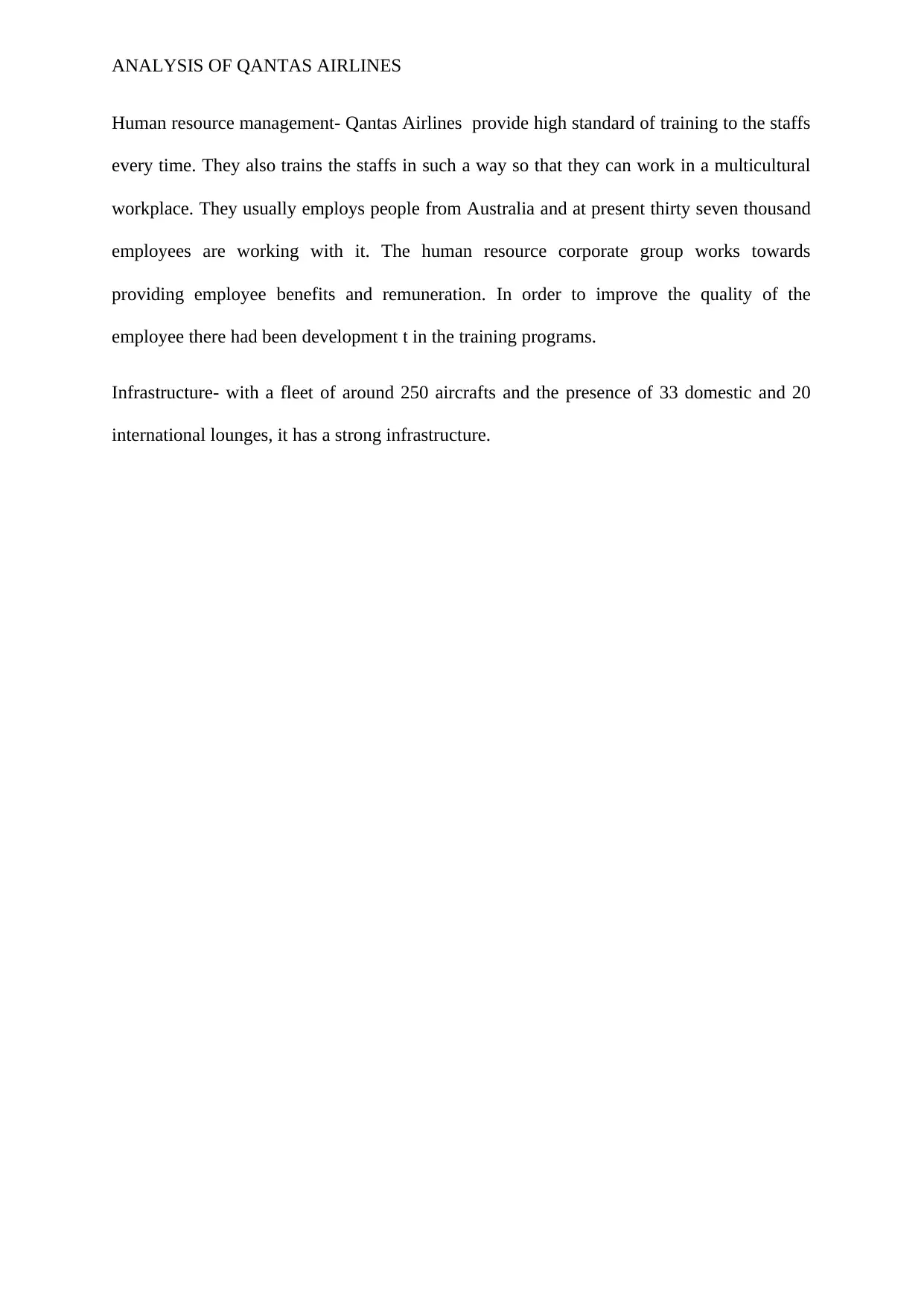
ANALYSIS OF QANTAS AIRLINES
Human resource management- Qantas Airlines provide high standard of training to the staffs
every time. They also trains the staffs in such a way so that they can work in a multicultural
workplace. They usually employs people from Australia and at present thirty seven thousand
employees are working with it. The human resource corporate group works towards
providing employee benefits and remuneration. In order to improve the quality of the
employee there had been development t in the training programs.
Infrastructure- with a fleet of around 250 aircrafts and the presence of 33 domestic and 20
international lounges, it has a strong infrastructure.
Human resource management- Qantas Airlines provide high standard of training to the staffs
every time. They also trains the staffs in such a way so that they can work in a multicultural
workplace. They usually employs people from Australia and at present thirty seven thousand
employees are working with it. The human resource corporate group works towards
providing employee benefits and remuneration. In order to improve the quality of the
employee there had been development t in the training programs.
Infrastructure- with a fleet of around 250 aircrafts and the presence of 33 domestic and 20
international lounges, it has a strong infrastructure.
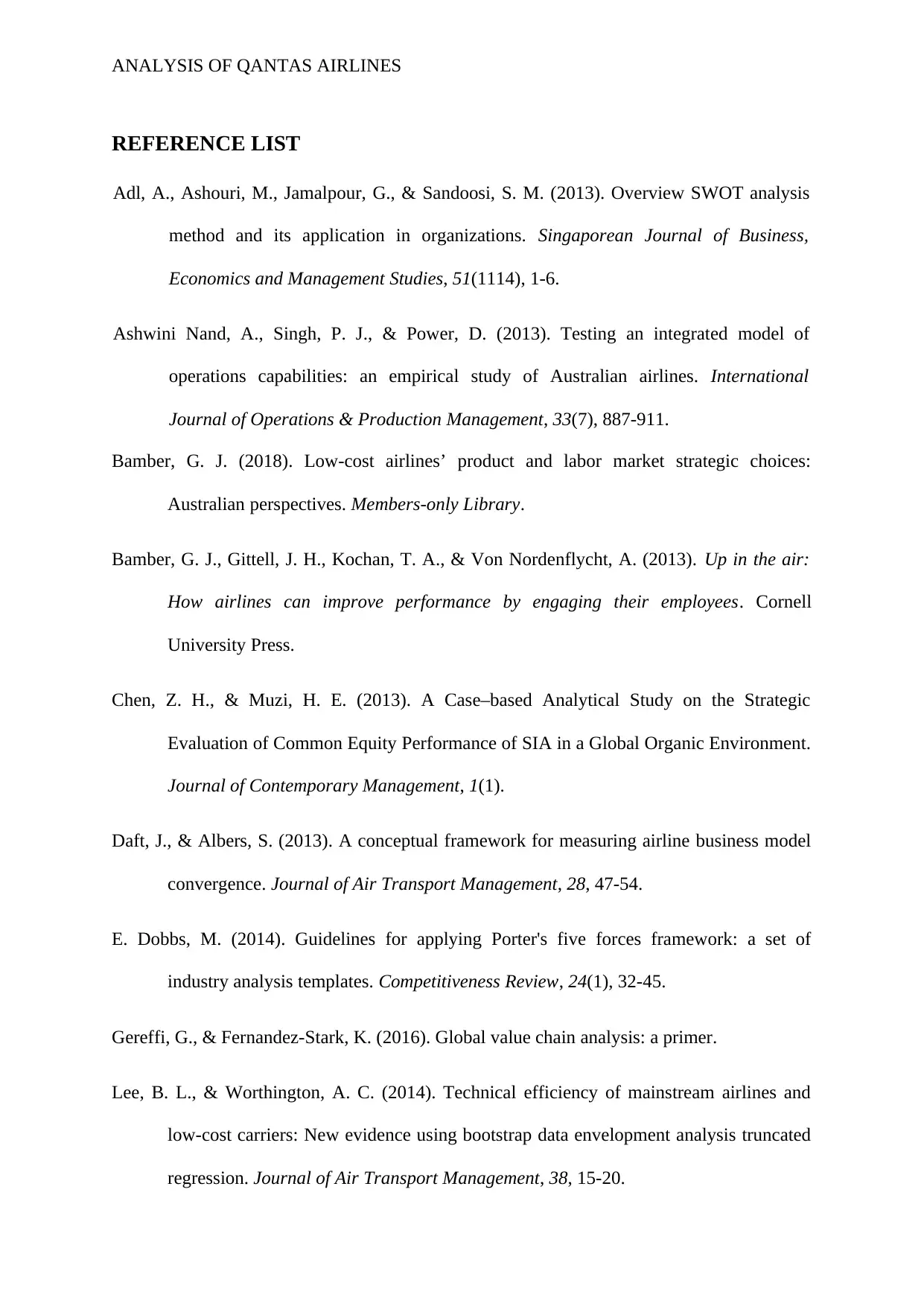
ANALYSIS OF QANTAS AIRLINES
REFERENCE LIST
Adl, A., Ashouri, M., Jamalpour, G., & Sandoosi, S. M. (2013). Overview SWOT analysis
method and its application in organizations. Singaporean Journal of Business,
Economics and Management Studies, 51(1114), 1-6.
Ashwini Nand, A., Singh, P. J., & Power, D. (2013). Testing an integrated model of
operations capabilities: an empirical study of Australian airlines. International
Journal of Operations & Production Management, 33(7), 887-911.
Bamber, G. J. (2018). Low-cost airlines’ product and labor market strategic choices:
Australian perspectives. Members-only Library.
Bamber, G. J., Gittell, J. H., Kochan, T. A., & Von Nordenflycht, A. (2013). Up in the air:
How airlines can improve performance by engaging their employees. Cornell
University Press.
Chen, Z. H., & Muzi, H. E. (2013). A Case–based Analytical Study on the Strategic
Evaluation of Common Equity Performance of SIA in a Global Organic Environment.
Journal of Contemporary Management, 1(1).
Daft, J., & Albers, S. (2013). A conceptual framework for measuring airline business model
convergence. Journal of Air Transport Management, 28, 47-54.
E. Dobbs, M. (2014). Guidelines for applying Porter's five forces framework: a set of
industry analysis templates. Competitiveness Review, 24(1), 32-45.
Gereffi, G., & Fernandez-Stark, K. (2016). Global value chain analysis: a primer.
Lee, B. L., & Worthington, A. C. (2014). Technical efficiency of mainstream airlines and
low-cost carriers: New evidence using bootstrap data envelopment analysis truncated
regression. Journal of Air Transport Management, 38, 15-20.
REFERENCE LIST
Adl, A., Ashouri, M., Jamalpour, G., & Sandoosi, S. M. (2013). Overview SWOT analysis
method and its application in organizations. Singaporean Journal of Business,
Economics and Management Studies, 51(1114), 1-6.
Ashwini Nand, A., Singh, P. J., & Power, D. (2013). Testing an integrated model of
operations capabilities: an empirical study of Australian airlines. International
Journal of Operations & Production Management, 33(7), 887-911.
Bamber, G. J. (2018). Low-cost airlines’ product and labor market strategic choices:
Australian perspectives. Members-only Library.
Bamber, G. J., Gittell, J. H., Kochan, T. A., & Von Nordenflycht, A. (2013). Up in the air:
How airlines can improve performance by engaging their employees. Cornell
University Press.
Chen, Z. H., & Muzi, H. E. (2013). A Case–based Analytical Study on the Strategic
Evaluation of Common Equity Performance of SIA in a Global Organic Environment.
Journal of Contemporary Management, 1(1).
Daft, J., & Albers, S. (2013). A conceptual framework for measuring airline business model
convergence. Journal of Air Transport Management, 28, 47-54.
E. Dobbs, M. (2014). Guidelines for applying Porter's five forces framework: a set of
industry analysis templates. Competitiveness Review, 24(1), 32-45.
Gereffi, G., & Fernandez-Stark, K. (2016). Global value chain analysis: a primer.
Lee, B. L., & Worthington, A. C. (2014). Technical efficiency of mainstream airlines and
low-cost carriers: New evidence using bootstrap data envelopment analysis truncated
regression. Journal of Air Transport Management, 38, 15-20.
⊘ This is a preview!⊘
Do you want full access?
Subscribe today to unlock all pages.

Trusted by 1+ million students worldwide
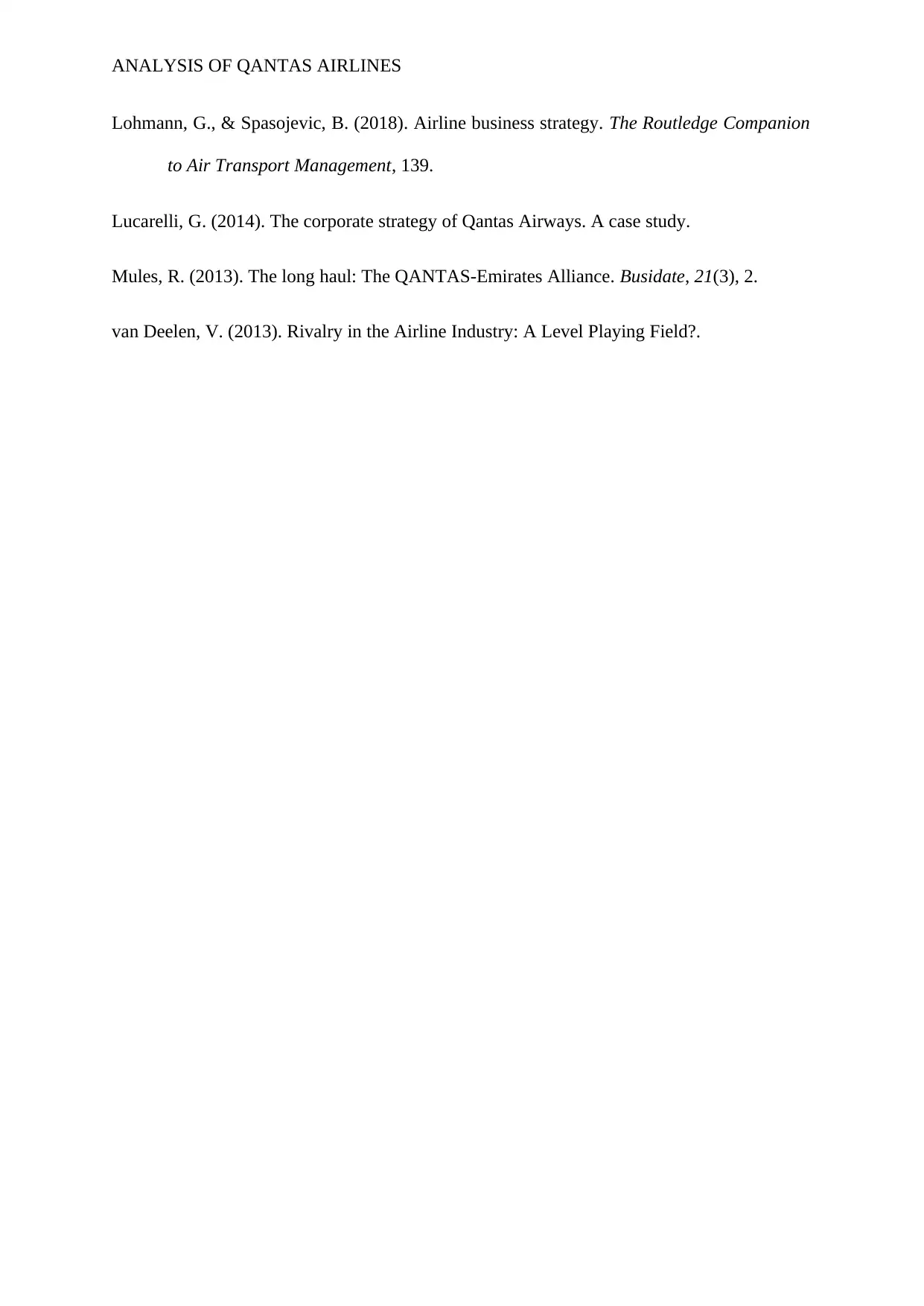
ANALYSIS OF QANTAS AIRLINES
Lohmann, G., & Spasojevic, B. (2018). Airline business strategy. The Routledge Companion
to Air Transport Management, 139.
Lucarelli, G. (2014). The corporate strategy of Qantas Airways. A case study.
Mules, R. (2013). The long haul: The QANTAS-Emirates Alliance. Busidate, 21(3), 2.
van Deelen, V. (2013). Rivalry in the Airline Industry: A Level Playing Field?.
Lohmann, G., & Spasojevic, B. (2018). Airline business strategy. The Routledge Companion
to Air Transport Management, 139.
Lucarelli, G. (2014). The corporate strategy of Qantas Airways. A case study.
Mules, R. (2013). The long haul: The QANTAS-Emirates Alliance. Busidate, 21(3), 2.
van Deelen, V. (2013). Rivalry in the Airline Industry: A Level Playing Field?.
1 out of 10
Related Documents
Your All-in-One AI-Powered Toolkit for Academic Success.
+13062052269
info@desklib.com
Available 24*7 on WhatsApp / Email
![[object Object]](/_next/static/media/star-bottom.7253800d.svg)
Unlock your academic potential
Copyright © 2020–2025 A2Z Services. All Rights Reserved. Developed and managed by ZUCOL.





